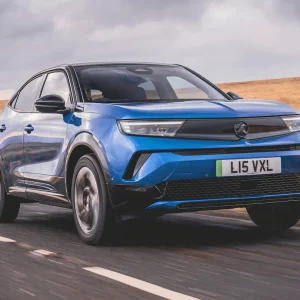
Despite Ford and Nissan exiting the UK small car market, Kia is celebrating the Picanto city car’s 20th anniversary – having sold a massive 260,000 to UK buyers.
There is no doubt, as we’ve said before this year, the market for superminis has shrunk. However, Kia’s UK President and CEO, Paul Philpott, was keen to tell us that behind the Sportage SUV, the Picanto is their second best-selling model in Kia’s UK history, and this facelift shows the company’s commitment to the sector!
Design themes
Outside, the biggest change for the Picanto mostly revolves around the styling, with the ‘Opposites United’ design themes that were first debuted in 2022 on the EV6 filtering their way down to the Picanto baby. At the front, there’s a new light bar, with LED headlights on top models, two types of front bumper, and the latest version of the family ‘tiger nose.’ Whilst at the back of this Kia, there’s another lightbar, bumper and tailgate. The result of these changes is the latest Picanto is a distinctive small car.
Inside, the instruments appear in a 4.2in driver display screen, and now all Picanto models are fitted with an 8.0in touchscreen with navigation, Apple Carplay, and Android Auto included as standard. The Picanto also surprises at how practical and spacious it feels considering it’s a small car – four adults could travel reasonably comfortably. Finally, the 255-litre boot is deep, with a reasonably low loading lip, and it can be extended to 1,010 litres with the rear seats folded.

As you’d expect, like every other model in the Kia range, even the entry-level 2 equipment grade is well-equipped, and although the plastics may be hard, the quality of fit and finish impresses. In fact, we’d say Kia has added polish to this new version of the Picanto, as it feels even more solid and well-made than ever.
Driving and performance
This Picanto is available with a choice of two engines, the first of which is a three-cylinder 1.0-litre petrol available with the 2, GT-Line, and 3 models. The 12-valve unit develops 62bhp and 93Nm of torque and can be combined with manual or automatic transmissions. Top speed is 90mph, with 0-62mph acceleration in 15.4 seconds for manual versions and 18.2 seconds for the auto. Of more interest for fleet buyers, is its 54.3mpg figure, CO2 emissions from 116g/km, and BIK figures from 27%.
The more powerful 1.2-litre 16-valve petrol engine, develops 77hp, with maximum torque of 113Nm, and is exclusive to GT-Line S models. Again, available with manual or automatic transmissions, it develops 77bhp with maximum torque of 113Nm. Top speed is 98mph, with 0-62mph acceleration in 13.1 seconds for manual versions, and 16.5 seconds for the auto. The manual version has CO2 emissions of 124g/km, with a combined fuel economy figure of 51.4mpg, while the AMT iteration has CO2 emissions of 128g/km, with 50.4mpg on the WLTP combined cycle.
We got the chance to drive what Kia believes will be the key fleet version, the 1.0 GT-Line. Despite its sporty look, we’d describe the Picanto as ‘fun,’ rather than particularly engaging. The ride on the bigger 16in wheels fitted here, is composed – but sometimes crashes, when the tarmac gets tough. Elsewhere, the steering lacks feel, but the five-speed manual transmission is reasonably slick and precise. There is some body roll in corners, but in general this Kia is a tidy handler.

Reports of the demise of the supermini sector seem premature in our opinion, and although this Kia isn’t at the top of the small car class, it’s a top player and worthy of consideration alongside talented rivals, such as the MG3 Hybrid and Suzuki Swift.
Positive: Distinctive looks, well-equipped, higher quality feel to the interior, easy and fun to drive.
Negative: Not a cheap option, rivals have more interior flexibility and practicality.
Standard equipment: 14in alloy wheels, power adjustable and heated door mirrors, manual air conditioning, power front and rear windows, 8in infotainment touchscreen with navigation, 4.2in driver display, rea parking sensors, cruise control.
| Model | Kia Picanto 1.0 GT-Line |
| P11D | £18,170 |
| Residual value | 50% |
| Depreciation | £8,670 |
| Fuel | £7,689 |
| Service, maintenance and repair | £2,053 |
| Cost per mile | 30.68p |
| Fuel consumption | 52.3 mpg |
| CO2 (BIK%) | 121g/km (29%) |
| BIK 20/40% a month | £87/£175 |
| Luggage capacity | 255 litres |
| Engine size/power | 998cc/272hp |
| Score | 7/10 |





